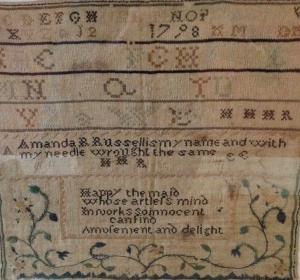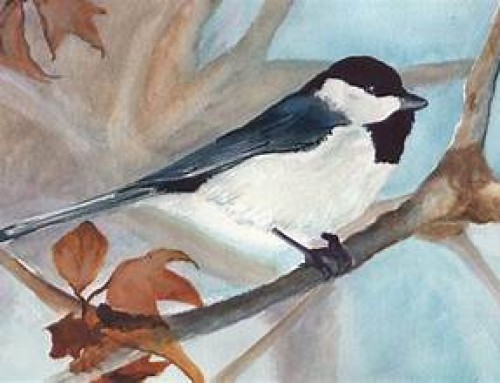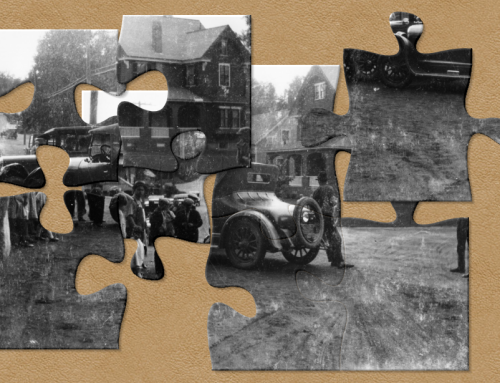Happy the maid
Whose artless mind
in works so innocent can find
amusement and delight.
At ten I learn from Gran, laying out
spools, hoops, her stork-shaped scissors,
the beehive thimble
Da whittled from the tumbled sugar maple
and the cotton threads I coveted
from Burton’s new store down to Norwich Plain,
deepest greens and blues for the big river.
All winter I wrestle my letters and numbers,
hands chapped from chores and chilled fingers
clumsy on the sampler’s rough linen.
Needle flashing in candlelight,
I space and set tiny crosses that glint
like stars in the dawn sky, picturing
Mother’s plentiful preserves
and the rows of seedlings in sister’s spring garden.
Tying the last knot, I sign my work:
Amanda R Russell is my name and
with my needle wrought the same.
Pausing by the hearth where it hangs,
my whole body flushes—
the flame alive and
leaping within me.
|
ARTIST STATEMENT Amanda R Russell Sampler, 1798 Ivy Schweitzer Needlework is an ancient skill and art, strongly associated with women. Because there were few pre-printed patterns available in Europe in the 16th and 17th centuries, needleworkers would sew a new stitch or pattern onto a small piece of cloth, called a “spot sampler,” to preserve and pass it on. Since fabric was expensive, women in England, Netherlands and Germany used narrow strips, which they covered with neat rows of stitches to create more elaborate “band samplers.” These were highly valued, often mentioned in wills and passed down through the generations. They included a wide variety of stitches, styles, threads, and ornaments, often incorporating small flowers, animals and geometric designs. They were often finished with the stitcher’s name and date of completion. Samplers were an important cultural and expressive form for women in colonial New England. By the 18th century, samplers became school exercises, like the slate or hornbook and, thus, become larger and squarer, with a border on all four sides. They served this educational function until the mid-19th century. Educational samplers were worked mostly in cross-stitch, and contained the alphabet, numbers, the girl’s name and often a verse from a poem or tract designed to foster and demonstrate virtue, piety and industry. They could become very elaborate, depending on the teacher’s knowledge and the girl’s skill, and were cherished and preserved. Samplers exhibit the importance of literacy for girls as well as for boys. When they married, girls would need to keep account of their family’s linen, and embroidering names, initials or numbers was a convenient means of identification. When framed and hung in the family parlor, samplers served to advertise the girl’s practical skills, literacy, and moral probity to potential suitors. The sampler I chose to write about was created by Amanda R Russell and is dated 1798—the Russells are listed as an early family of settlers in Norwich. It is probably a “marking sampler,” the simplest kind and the first exercise in a girl’s sewing education, because it contains many practice letters placed randomly, and because the verse was worked on another piece of fabric and sewn in. I was drawn to this object because I wanted to imagine the artistic life of a young girl in Norwich at the turn of the 19th century. What outlets would she have had for her creativity? Also, rather than accepting her as “artless,” as the pious verse intones, I wanted to reclaim the “art” in her creation. I imagine Amanda learning the art of needlework from her grandmother, but there was a public grammar school in Norwich at the time, which opened in 1785 on the site of the present Congregational Church, and Amanda could have attended and learned needlework there. I also mention the new store opened by Mr. Burton in 1798 that might have been the source of the special colored threads Amanda yearned for, to symbolize the Connecticut River, which would have been a dominating geographical feature in her life. All of this betokens new developments and expansion for Norwich as it moved into the next century. I imagine Amanda working through the long winter and late into the nights, thinking of her mother’s “art” of canning and preserving the products of her sister’s “art” of gardening, longing to be part of that “art full” female tradition of domestic and subsistence skills, and finally so proud of her accomplishment. It made me think of teaching my own daughter to knit and crochet, passing on those “arts” to her. I found the same motto stitched onto a sampler dated 1826 in Ethel Stanwood Bolton and Eva Johnston Coe, American Samplers, Massachusetts Society of Colonial Dames of American, 1921. NY: Weathervane Books, 1973 About Ivy: I hail from Brooklyn, New York, but have lived for many years in Norwich, Vermont, where I teach American literature and Women’s and Gender Studies at Dartmouth College. I have published poetry in Birchsong: Poetry Centered in Vermont, The Glass Seed Annual, Solidus 3 (with interview), and in the last four issues of Bloodroot Literary Magazine. Currently, I am co-editing the digital revival of Bloodroot and beginning a hybrid critical/creative blogging project about a year in the life of Emily Dickinson. |



